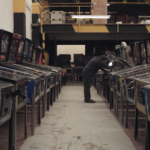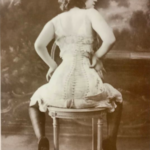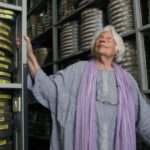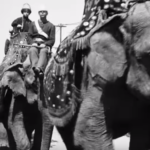Two Great Collections of Jazz on Film Become One
Two of the most impressive collections of films of jazz and other American popular music have combined: Celluloid Improvisations Music Film Archive and the storied archive of David Chertok, The Chertok Jazz on Film Collection.
n
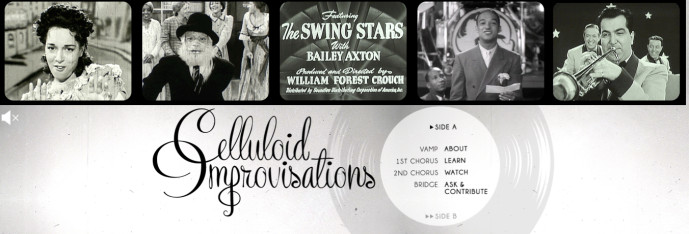
n
Imagine Basie and Ellington’s crews, forces joined.
In the jazz-on-film version of such an aggregation, Mark Cantor, who has for more than 45 years operated Celluloid Improvisations in California in recent months reached a merger agreement with Michael Chertok, manager of the collection that his father began to gather in 1957.
The result is “a premier collection of jazz and American popular music preserved on 16mm sound film,” says Cantor, from his office in Agoura Hills.

Mark Cantor
The deal stems from Cantor’s longtime friendship with the Chertoks. “David was a dear friend of mine, and in fact I think I was up with him in New York the last time he was well enough to screen films,” Cantor says. Before David Chertok died in 1988, aged 66, his son Michael had taken the reins. Cantor and David Chertok had both toured selections from their archives throughout the US, and also internationally, and Michael Chertok took to doing the same, sometimes in collaborations with Cantor. He built his father’s 400-plus hours of footage of jazz musicians, which could boast pretty much every notable jazz musician who had ever been filmed, into some 800 hours of footage of performances of jazz and other musical genres.
After Chertok cast about for ways to manage his father’s legacy, “he decided the time had come to move the films elsewhere,” says Cantor. Cantor’s warehouse seemed like a good option.
It will take Cantor a long while to catalog all the films and to organize extensive supporting notes about them into a data base while also digitizing the films to make material available for licensing to filmmakers and commercial entities, and to provide it to scholars and students of jazz. He is first checking the condition of the Chertok films, which although not always kept in ideal storage conditions, have survived well. “All things considered, the amount of vinegar syndrome is surprisingly low,” Cantor says, referring to a common form of deterioration, with smell to match its name.
He has stored the films in a humidity-controlled vault and takes home a few items at a time to prepare annotations — and to savor. “Part of this is going to be a very exciting treasure hunt,” he says. “Right now I have a can of film in front of me, I have no idea what is in it, but it’s labeled “Benny Carter/Stan Getz/Dexter Gordon/Art Pepper.” Well, those are four of my favorite musicians and I’m just curious what the heck is on this film.”
The Chertok collection, like Cantor’s, is rich. Its precise history is a little clouded in time. An obituary in The New York Times noted of David Chertok that he came from Poland to New York as a child, and took to collecting jazz films in 1957 while working in the nascent stock-footage industry. He was apparently at his brother Bernard’s Sherman-Grinberg Film Library, the first stock-footage company, which represented Paramount and Pathé newsreels and ABC News. By either the late 1960s or early 1970s – sources differ — he was working on his collection full time, seeking out footage from American and European theatrical films, documentaries, and television programming, and by the mid-1970s, as he explained to a Philadelphia newspaper, was frequently traveling to talk about and exhibit his rare footage of jazz greats.
An account he gave in 1983 to the Ann Arbor (Mich.) News differed slightly. He said that he began collecting in 1966 after a customer at the New York film library asked him to locate some film clips of jazz musicians: “I’d always like jazz, ever since I was a kid growing up during the Big Band era. But this was the first time I’d ever seen jazz performances on film. Boy, let me tell you: I was hooked. I quickly became convinced that jazz films are the ultimate in collecting jazz memorabilia. It’s one thing to collect rare records. But it’s quite another to see dead performers or performers well past their prime giving the performance of their lives.” After that footage aired on network television in 1967, the customer gave it to him. And “ever since then, collecting jazz clips has been like a dream come true,” he told the Ann Arbor News.
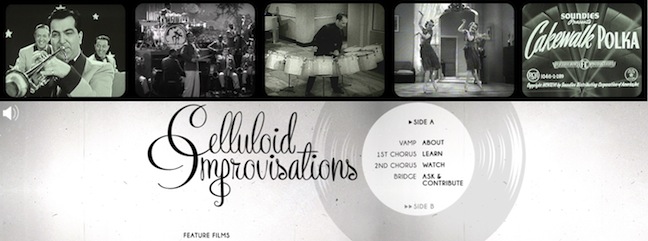 He shared his love for jazz on film — on film, not video, which he considered lacked clarity — by taking material from his archive to nightclubs, concert halls, colleges, and jazz festivals in the U.S., and around the world. He also edited his films for television specials. He preferred the jazz canon: major figures from Bessie Smith and Louis Armstrong, through Duke Ellington and Count Basie, to Billie Holiday, Miles Davis, and John Coltrane. He professedly had little time for free jazz or later iterations, but did come to appreciate the bebop of the late 1940s, on.
He shared his love for jazz on film — on film, not video, which he considered lacked clarity — by taking material from his archive to nightclubs, concert halls, colleges, and jazz festivals in the U.S., and around the world. He also edited his films for television specials. He preferred the jazz canon: major figures from Bessie Smith and Louis Armstrong, through Duke Ellington and Count Basie, to Billie Holiday, Miles Davis, and John Coltrane. He professedly had little time for free jazz or later iterations, but did come to appreciate the bebop of the late 1940s, on.
Putting together a collection like his could be done in part due to a quirk of copyright history that he discovered because he was intent on avoiding using any copyrighted material, as he explained to the Philadelphia Daily News in 1987: “For a long, long period, television people didn’t copyright anything. This was before the advent of videotape. They were making kinescopes but they had no convenient way to copy it, so why go through all that work and expense sending copies of everything to the Library of Congress?”
Of course, his impeccable taste was another key. One of his two-hour presentations might include “theme reels” with, as he once detailed, “three great tenor saxophone players, Coleman Hawkins, Sonny Rollins and Johnny Griffin. Then I’ll have a vocal reel with Nat King Cole, Sarah Vaughan, Dinah Washington, and a wonderful Dizzy Gillespie scat session with Sarah and Joe Carroll. Also, a newly found Miles Davis from his great 1967 quintet with Herbie Hancock, Wayne Shorter, Ron Carter, and Tony Williams. And some very rare Oscar Peterson, and some Benny Goodman, Charles Mingus, Count Basie, Bill Evans.”
In an article in the New York Sun, prominent music journalist Will Friedwald referred to David Chertok as “the godfather of jazz on film” for his long history of “concert-like shows” of jazz films that also in many cases found their way to fans far and wide via his collaborations with companies like Reelin’ in the Years and its Jazz Icons DVD series.
What we today know of how jazz looked in mid-century is a result of the efforts of the likes of Cantor, the Chertoks, and a few other collectors, including John Baker, all of whose hordes have permitted a healthy commercial trade in jazz on DVD and other platforms.
Baker was a Columbus, Ohio, lawyer with a passion for jazz on film who from the 1940s built a major collection of 78rpm recordings and then, while stationed in New York with the U.S. Navy, stumbled upon jazz “soundies” (juke-box short films of the 1940’s — see, below) selling in a store for 19 cents each. Back home in Ohio, he continued to build a formidable jazz-film collection that he would exhibit at home gatherings for jazz buffs and visiting stars like Louis Armstrong, Eubie Blake, and Jack Teagarden.
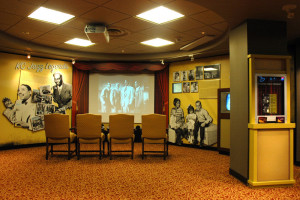
John Baker Film Collection, American Jazz Museum, Kansas City
The Columbus Dispatch described the collecting of Baker, a lawyer who didn’t make much money and spent it all on jazz film, to his family’s distress, as an obsession. He came to focus solely on jazz film, bankrolling his activities by selling first a collection of jazz piano rolls, and then, in 1972, his 10,000 jazz records. He traveled widely to present gems from his collection, and displayed a staggering mastery of the films’ contents, but less business acumen. By the time his films became essential to a growing, albeit never large commercial market in jazz film that spawned numerous television and film retrospectives of the art form, his name often went unmentioned because he had long ago traded away film to other collectors.
In 1984, to fund his retirement, Baker sold his collection of films and his trove of notes about them to the University of Kansas for $200,000. By the time he died, in 1998, he had seen the films languish in an underground warehouse and neglect. And he would have had to survive another decade, until 2009, for an announcement from the American Jazz Museum that it had completed a decade-long process of inspecting, restoring, and digitizing a portion of the collection’s more than 5,000 titles, one million feet of 16- and 35-mm black-and-white and color films – about 700 hours’ worth – dating from 1927 through the early 1970s. A $312,000 federal grant enabled the museum to do that work, and to set up an exhibit with sections for soundies (see, below), movie clips, and television video.
Thanks to Baker and those who came after him, many devotees of jazz have been able to see the likes of the material in a typical Chertok presentation, as Will Friedwald described one: Rahsaan Roland Kirk playing three saxophones simultaneously at a 1967 Norway performance, and earlier at a 1963 Belgium studio set with Milt Jackson; pianist Oscar Peterson in Sweden, the same year; Bill Evans “in his characteristic pose, his head hanging limp like a rag doll, too focused on the music to notice the cameras or, for that matter, the crowd”; Nina Simone, “possibly the most extroverted keyboardist-singer in all of jazz or pop — yet also one of the most subtle,” in 1965 and 1968 appearances; Sonny Rollins flying in 1959 with a young Henry Grimes on bass.
While films of jazz performance, whether drawn from feature films, television broadcasts, or recordings of live performances, aren’t the most in-demand kinds of footage, Cantor and a small coterie of other collectors are kept busy. Cantor’s client list over the years has grown long and varied. Many producers of feature and documentary films, television programs, and film festivals have used his material, as have makers of associated products such as CD-ROMs, DVDs, and websites. Ken Burns drew on Cantor holdings for his public-television series, Jazz, as did the makers of A Great Day In Harlem, the Academy Award-nominated documentary film about a particularly famous jazz photograph. Cantor also has advised creators of many documentary and feature films, books, and magazine articles, written liner notes for jazz recordings, and produced some, too.
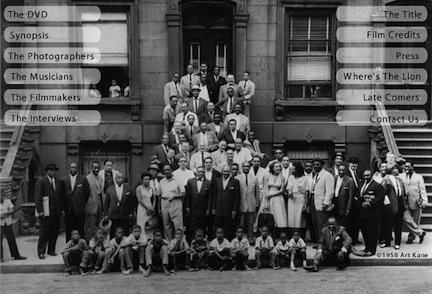
“A Great Day in Harlem.”
Eventually, Cantor will provide details of all the titles of the combined collection on his existing Celluloid Improvisations website, to which he also will transfer the samples of his collection that are on his YouTube channel. It is on his website that one of his great strengths as a collector emerges: his dedication to providing a wealth of supporting documentation for as many of his films as he can.
Jazz fans are famously hungry for details — biographical, bibliographical, any kind — and Cantor doesn’t skimp. He lists not only the obvious key facts — who played what, when, where, and much else — but also, whenever he can, such minutiae as what is known about musical performances’ players, soloists, composers, lyricists, and arrangers, and even, say, the times and locations of so-called “sideline photography” (shots of a band’s mimed performance of its own or another group’s recording, a common film practice after 1930). He pays attention even to soundtrack musicians and on-screen or “sideline” performers, including musicians, dancers, and variety artists.
Cantor plans to provide these exhaustive assortments of information about all the films of the new, combined collection, a daunting task. He says “there is a network of people worldwide I can turn to, who help with the identifications,” but by far the bulk of the task falls to him. “For me,” he says, “recording that information is just as important as the preservation of the films.”
To explain his thoroughness, he recalls something the trumpeter Harry “Sweets” Edison told him: “He said, ‘I’m going to share with you some information but I want you to check things out with sidemen.’ He said he was really concerned that the second alto man, or the third trumpet player… that these men would get their due in terms of maintaining their identity. ‘Because,’ he said, ‘the sidemen in these bands…’, the way he put it was, ‘our asses were kicked from one coast to the other.’”
The results are impressive, and dependable. Michael Steinman, who operates the Jazz Lives blog, calls Cantor the “renowned (diligent but never stuffy) scholar of jazz on film.” Ken Burns has called his collection “one of the very best collections of jazz films in the world,” saying Cantor “was an invaluable asset to our Jazz series whose generous advice helped us unearth some extraordinary footage.”
Cantor will need some time before he can tally the items in the merged collection, but before it he had recordings of 4,000 separate performances, for the most part on 16mm sound film, with some videotapes, laserdiscs, DVDs, and various digital formats where, for example, jazz performances on 16mm were too brief to warrant the expense of acquiring the footage. For instance, he says, back in the early 1930s, if Warner Bros., RKO, or Columbia wanted a black band for a nightclub scene, they would often call Frank Sebastian’s Cotton Club in Culver City, Cal., and round up some jazz musicians, either to record the track and appear, or just to sideline on film, and they may be on screen for just 15 seconds. “Well, on the one hand,” says Cantor, “it’s important to data base their presence because very often it’s a less-hyped band and we might have Lionel Hampton on drums, or Marshall Royal on alto sax, and it’s important information to have on the data base. But I’m not going to buy that feature for $150 for 15 seconds worth of screen time.” Well, he adds, “I would if I could, but I’m not in that position, so I’m happy to have it on DVD if an inexpensive film copy doesn’t come along.”
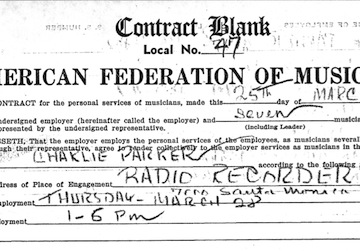 The bulk of his collection relates to jazz, but some items feature allied American musical forms such as blues, swing, Western swing, rhythm and blues, and vaudeville and variety. He breaks down the kinds of items in various ways, including by such categories as feature film, short subjects, soundies, tv broadcasts and Kinescopes, and miscellaneous others. The last category includes rare production documents such as Charlie Parker’s 1946 contract with Dial Records.
The bulk of his collection relates to jazz, but some items feature allied American musical forms such as blues, swing, Western swing, rhythm and blues, and vaudeville and variety. He breaks down the kinds of items in various ways, including by such categories as feature film, short subjects, soundies, tv broadcasts and Kinescopes, and miscellaneous others. The last category includes rare production documents such as Charlie Parker’s 1946 contract with Dial Records.
Even with only his pre-merger collection’s holdings, Cantor’s data base runs to hundreds and hundreds of pages. As yet, a relatively small portion of that is up on his website because, he says, “I just haven’t had the time” to proofread and format it. His notes began as entries in spiral notebooks before he switched to a computerized database; many of them registered in his memory, so that when potential licensors or renters enquire, he will at least know where to look: “I can pretty much answer most questions without referring to the computer, but if someone has seen a clip of say, Hal McIntyre’s band, and wants to know who the tenor soloist is, I can say ‘I think it’s Ted Goddard, but I’ll have to check.’ But I’m pretty much familiar with what is here and what is not here.”
He continues to add items. “Mostly these days films come from other collectors who want to pass them on,” he says. That often means that he gets his new films through eBay, which he also will use to sell duplicates in the combined collection, so he can purchase new 16mm prints he doesn’t have (and he will prefer 16mm because that is the first form of film that will have been struck from the film negatives, and its music tracks will be the version of the music that is closest to what was actually played).
The market is unpredictable and often nonsensical. For example, Cantor says, he recently noticed a three-minute “soundie” online of Les Brown and Doris Day, described as “extremely rare” although it was something he has several copies of. “I can’t figure it out,” he says. “And I’m not going to be the next person in line to call something ‘rare’ when it’s not.”
He is alert, however, for items that might pop up, including ones that would shock him by existing, at all: “films that are on every jazz collector’s wish list,” by which he means something, anything, with 1940s electric-guitar pioneer Charlie Christian, trumpeter and 1940s drug-habit casualty Fats Navarro, and pianist/arranger Tad Dameron — “people you we listen to and love but there are no films of,” or at least only rumored elusive snippets.
The market isn’t so hot that prices are likely to be high for most individual films that turn up. In any case, he says, “right now I’m so overwhelmed with what’s here, I haven’t any idea of what I’d want, and certainly I don’t have the resources to pull anything in.”
For special needs, Cantor works with a couple of partners, one of them the University of California at Los Angeles: “When I turn up a film that I’m fairly certain is a one-of-a-kind item, I deposit it there. That doesn’t mean they have ownership; it means they can use it for academic purposes, and I know that the film is well cared for. It’s safe.”
Cantor’s accomplishment is all the more remarkable given that he remained a teacher at various levels of the educational continuum, from kindergarten to college extension, until he retired in 2011. He came up in the Los Angeles public schools, got a degree in English literature and history from the University of California at Santa Barbara with a minor in music and then began teaching. That was in 1971, and he remained a teacher until 2011.
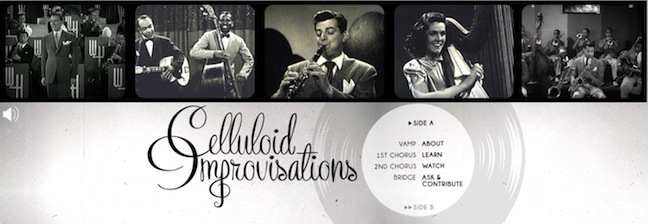 Although passionate about collecting, he appears admirably sane about it, which cannot always be said. He began at 12, when an uncle gave him a collection of old jazz 78s. In his late teens, he stumbled upon a film can labeled “jazz movie” in a record store, brought it home, and discovered, as he told the Los Angeles Times in 1993: “Suddenly, there were the people I had been listening to all those years” — Lester Young, “Sweets” Edison, Illinois Jacquet, Jo Jones… “The sound and the image on that film were so compelling,” he told the Times, “that I was totally drawn in. I was mesmerized by the performances. I had to see more.”
Although passionate about collecting, he appears admirably sane about it, which cannot always be said. He began at 12, when an uncle gave him a collection of old jazz 78s. In his late teens, he stumbled upon a film can labeled “jazz movie” in a record store, brought it home, and discovered, as he told the Los Angeles Times in 1993: “Suddenly, there were the people I had been listening to all those years” — Lester Young, “Sweets” Edison, Illinois Jacquet, Jo Jones… “The sound and the image on that film were so compelling,” he told the Times, “that I was totally drawn in. I was mesmerized by the performances. I had to see more.”
He schooled himself in libraries on collectors’ magazines and the like, then took to scouring swap meets, garage sales, flea markets… the usual.
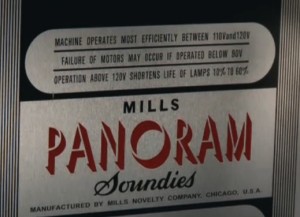 Since retiring, he has taken on one more project, in progress, a book on Panoram “soundies,” the juke-box short films of the 1940’s. (See Michael Feinstein on his American Songbook public-television program discuss those films with Cantor in this clip.) He explains that users of the machines, which were placed in bars, restaurants, pool halls, and the like, operated the machines by depositing a coin, but didn’t select what would play. Owners of the establishments purchased the Panoram viewer, which was the size of a large television set, and then each week would receive a reel of eight “soundies.”
Since retiring, he has taken on one more project, in progress, a book on Panoram “soundies,” the juke-box short films of the 1940’s. (See Michael Feinstein on his American Songbook public-television program discuss those films with Cantor in this clip.) He explains that users of the machines, which were placed in bars, restaurants, pool halls, and the like, operated the machines by depositing a coin, but didn’t select what would play. Owners of the establishments purchased the Panoram viewer, which was the size of a large television set, and then each week would receive a reel of eight “soundies.”
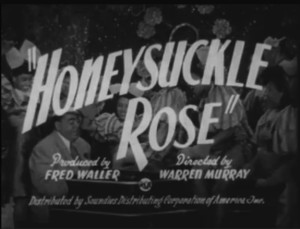 Cantor says: “It was very carefully crafted. There would be a couple of band numbers; there would be what were called ‘song stories’ where a singer sings but we act it out on screen; there would be a couple of novelty pieces or a Hawaiian piece; invariably the eighth position was taken by an African American group.” In the first throes of the phenomenon, the machines proved popular — the music-related film in a box, a proto-music video “was something people had never seen before,” Cantor told Feinstein. Between the summer of 1940 and the end of 1946, some 1,870 soundies circulated on Panoram machines, generally by relatively well-known artists. (Cantor has about 1,400 of the films; he writes about the format, here.).
Cantor says: “It was very carefully crafted. There would be a couple of band numbers; there would be what were called ‘song stories’ where a singer sings but we act it out on screen; there would be a couple of novelty pieces or a Hawaiian piece; invariably the eighth position was taken by an African American group.” In the first throes of the phenomenon, the machines proved popular — the music-related film in a box, a proto-music video “was something people had never seen before,” Cantor told Feinstein. Between the summer of 1940 and the end of 1946, some 1,870 soundies circulated on Panoram machines, generally by relatively well-known artists. (Cantor has about 1,400 of the films; he writes about the format, here.).
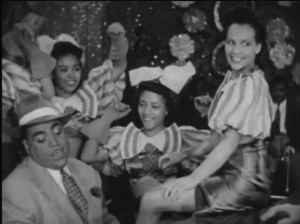 But World War II suppressed production, and in the postwar years club attendance dropped as family life boomed, “so there just weren’t enough dimes going into the machines to keep the enterprise going.”
But World War II suppressed production, and in the postwar years club attendance dropped as family life boomed, “so there just weren’t enough dimes going into the machines to keep the enterprise going.”
Cantor also continues to present jazz-film series in San Francisco each year and programs around Los Angeles and his hometown of Agoura Hills. “It isn’t the type of thing that is as popular as it used to be because you can go to YouTube now and create you own program,” he says. “But what I do is a little bit different. As much as we thrill to hearing a recording of, say, Coltrane and Monk, seeing that spontaneous creation of music is, viscerally, a much more intense experience.”
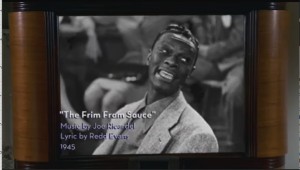
Screen grabs from “soundies”
Filmmakers and others who wish to license material from Cantor’s collection deal with him, directly. In general that’s a matter of reaching a happy agreement, part of whose calculation, Cantor says, is that at his point in life, in his mid-60s, “I just don’t have time for difficult people.” He has a family, grandkids, ski weekends calling…
There’s no real rigid price structure, he says. Clint Eastwood, with whom he has worked, will obviously have a deeper pocket than, says, an independent or student filmmaker. Cantor recalls a Canadian filmmaker who once contacted him: “She cited a price that was way, way below what I would generally accept for a licensing deal. But I didn’t know what the topic of the documentary was.
“I asked, ‘What are you doing?’
“She said, ‘Well, I’m making a documentary about Canadian yodelers.’…at which point I said, ‘Honey, the clip is yours.’
“Anyone who has the chutzpah to do a documentary on Canadian yodelers needs my support.”
— Peter Monaghan
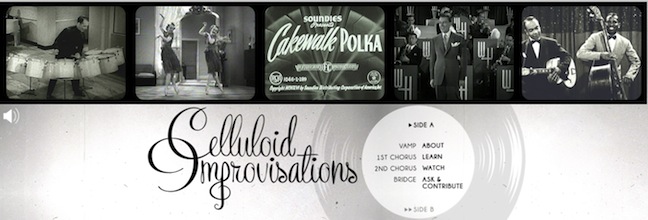
Previous Post: African American Home Movies: Are They Out There? Can You Help Locate Them?
Next Post: 25 Films Added to the U.S. National Film Registry

